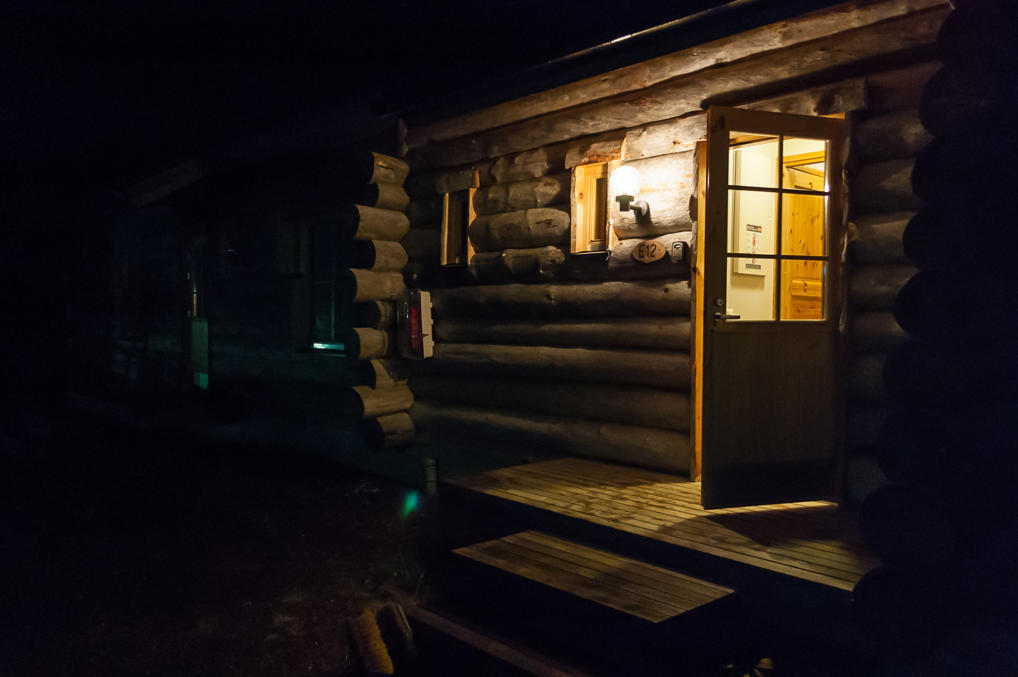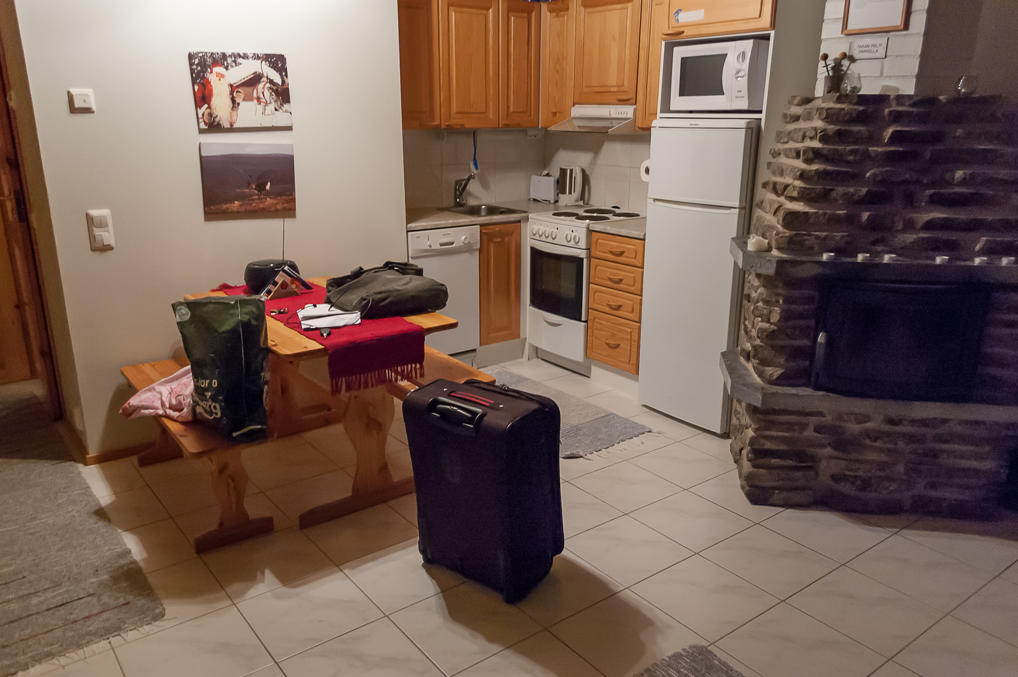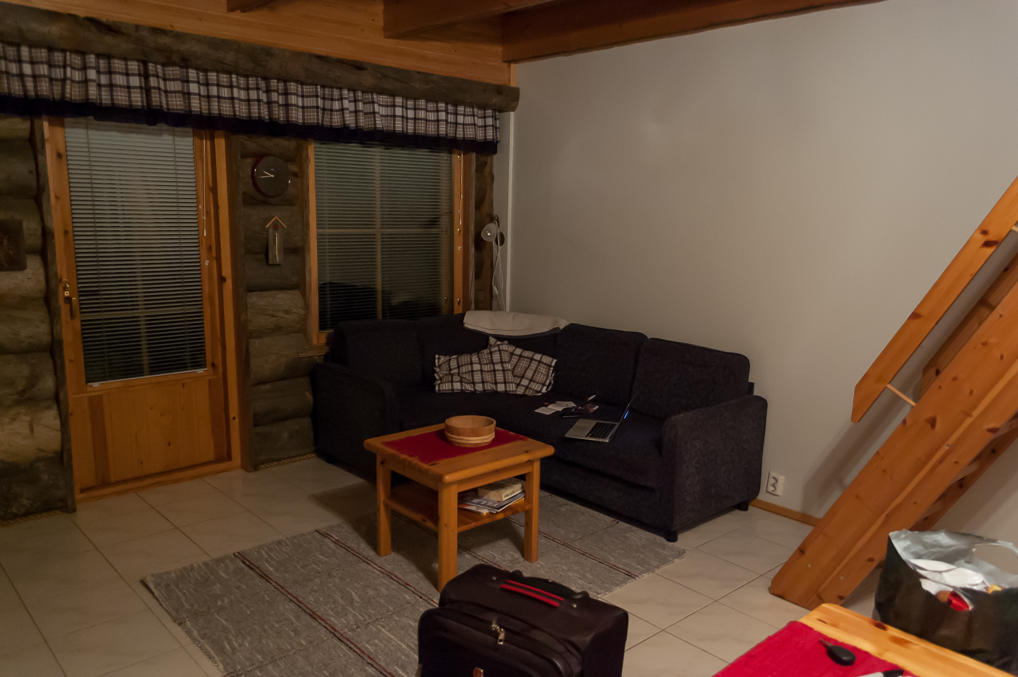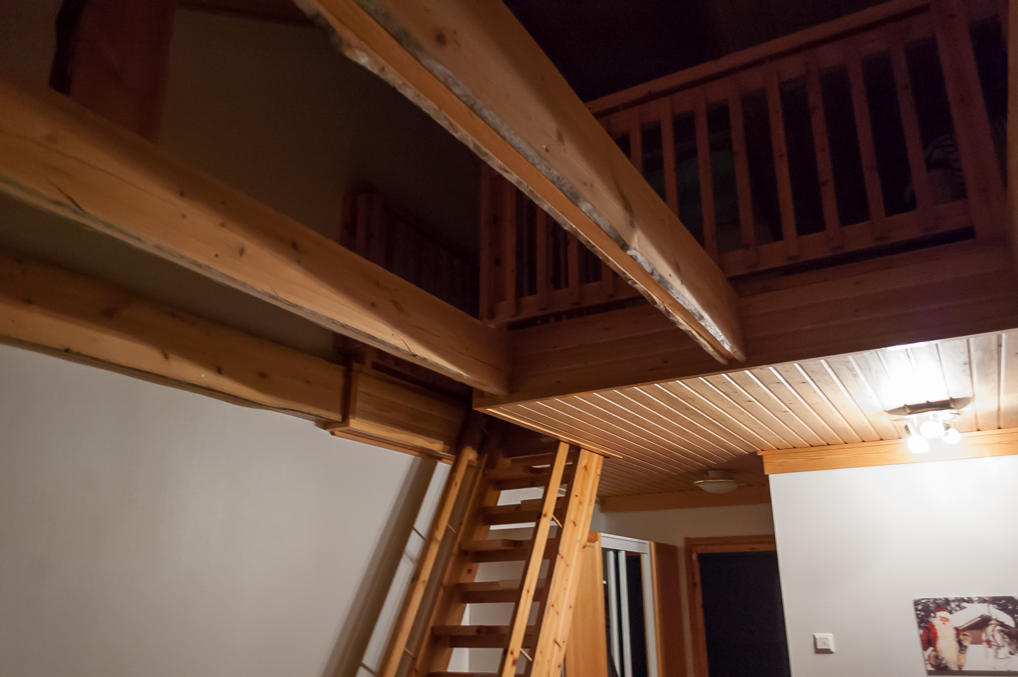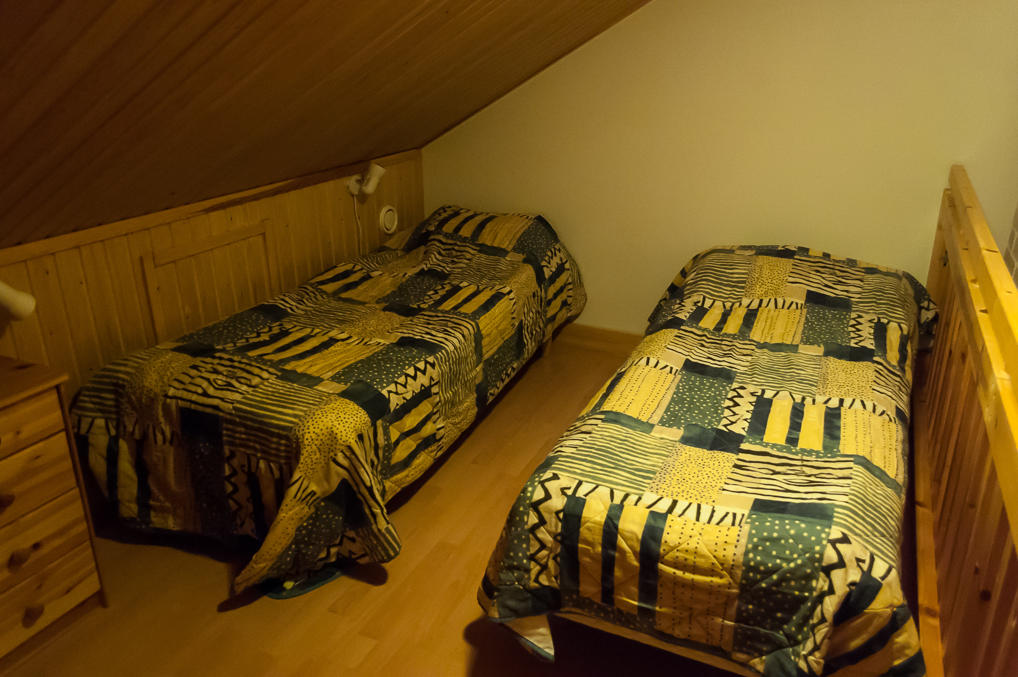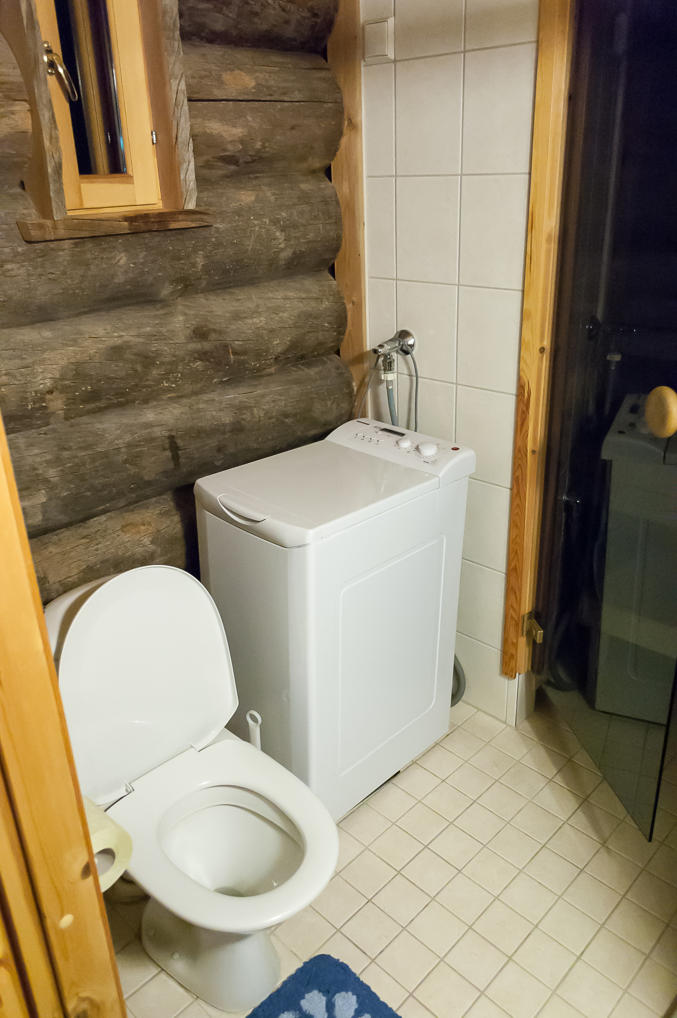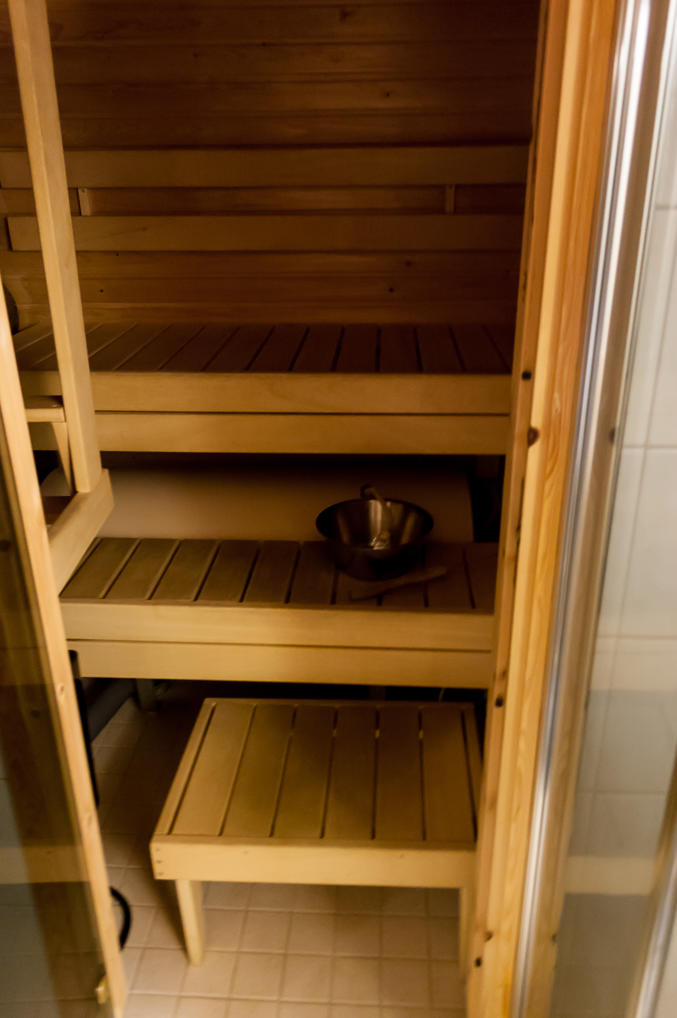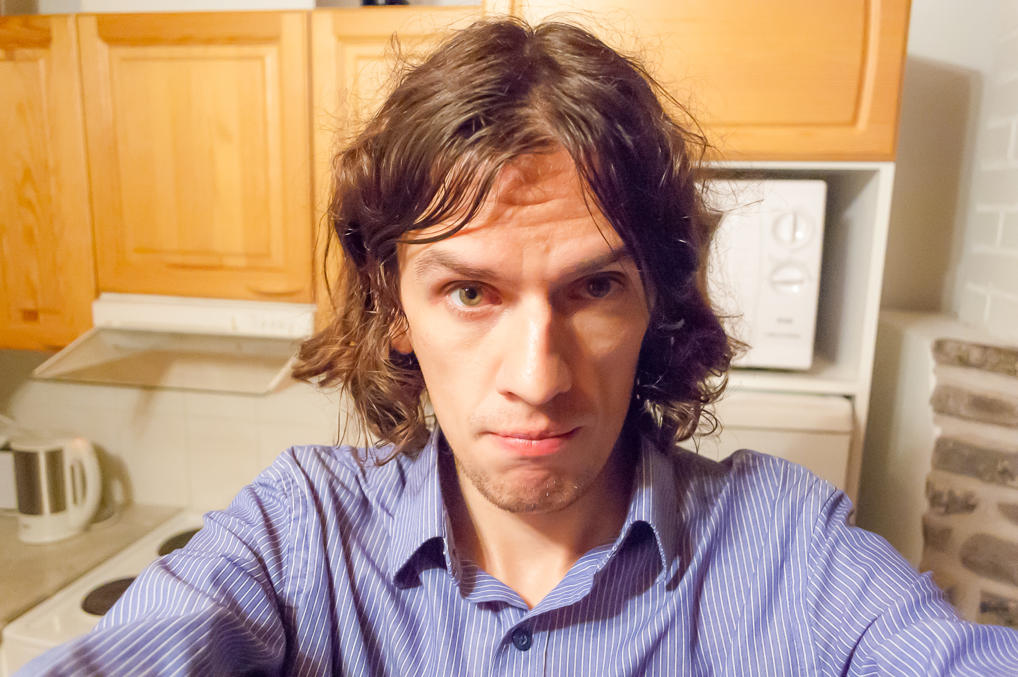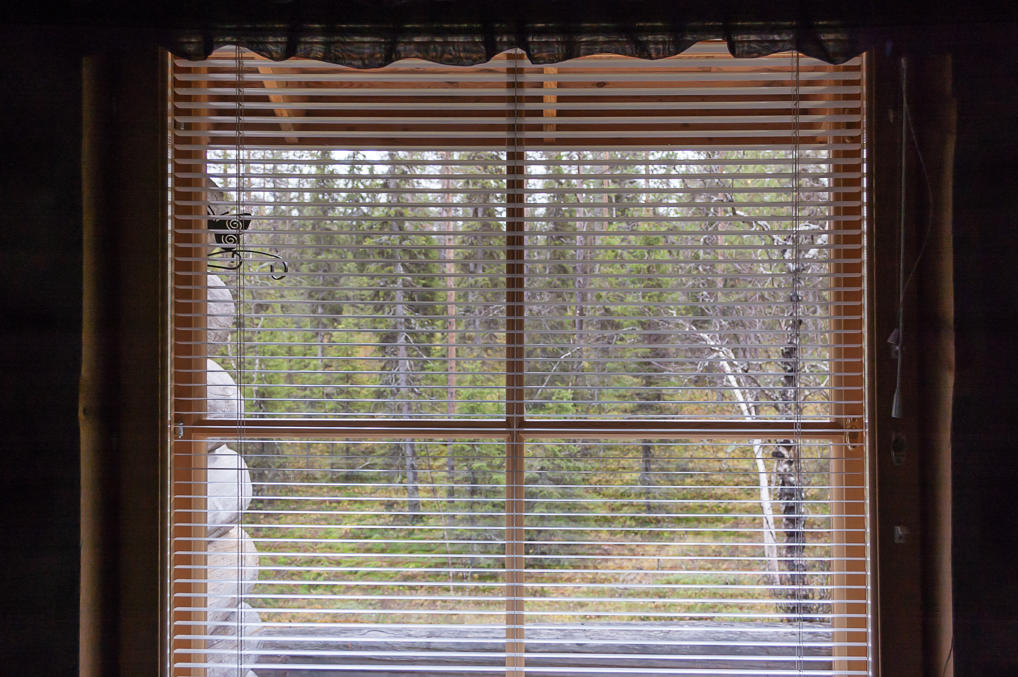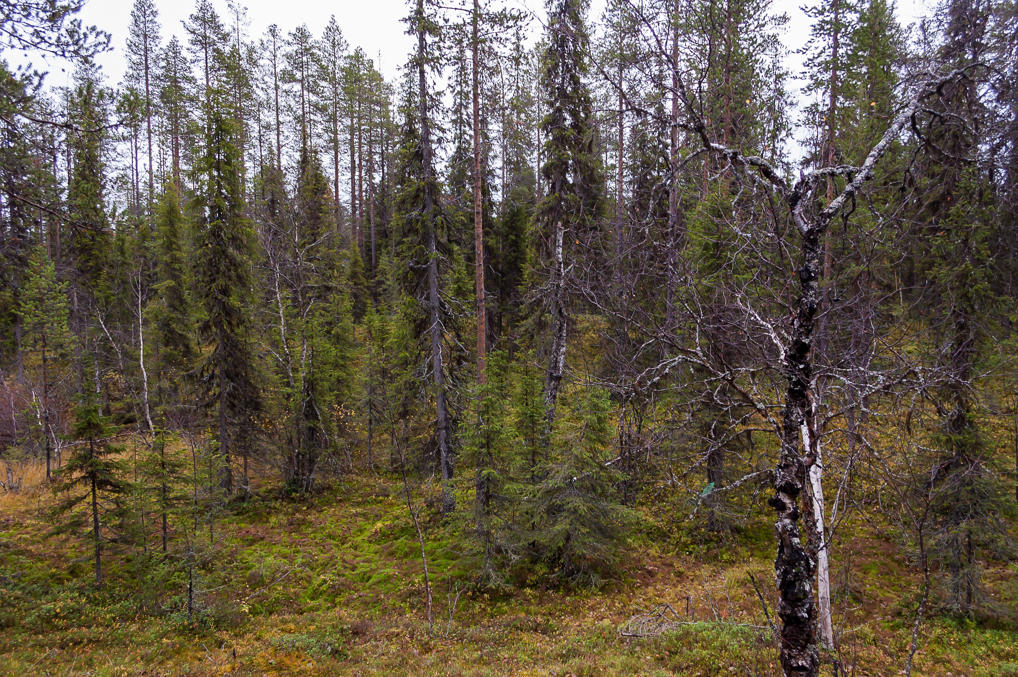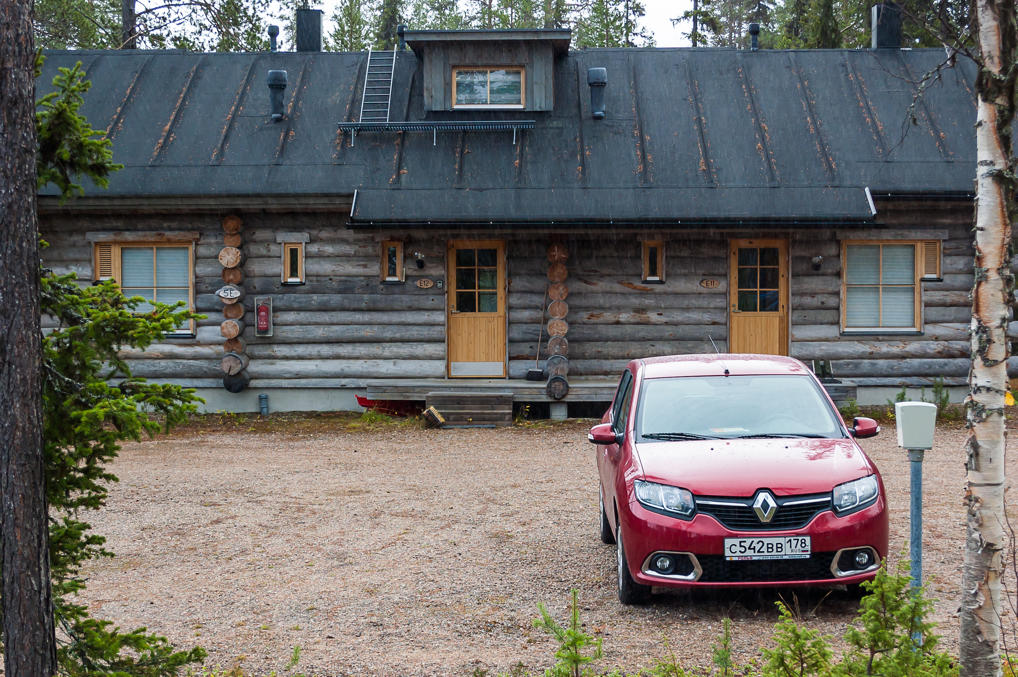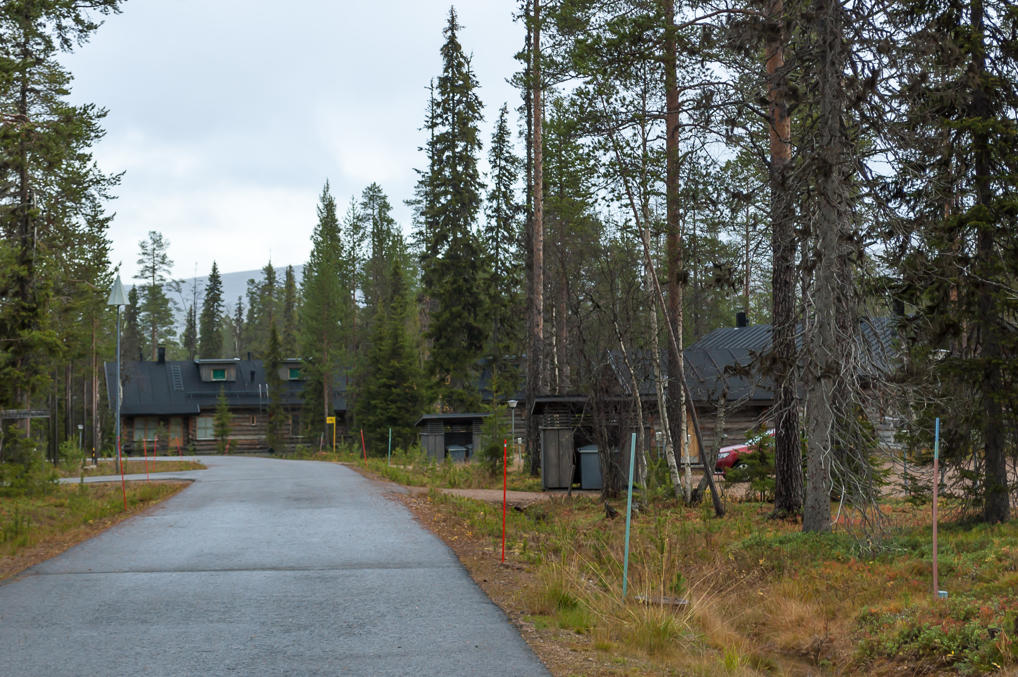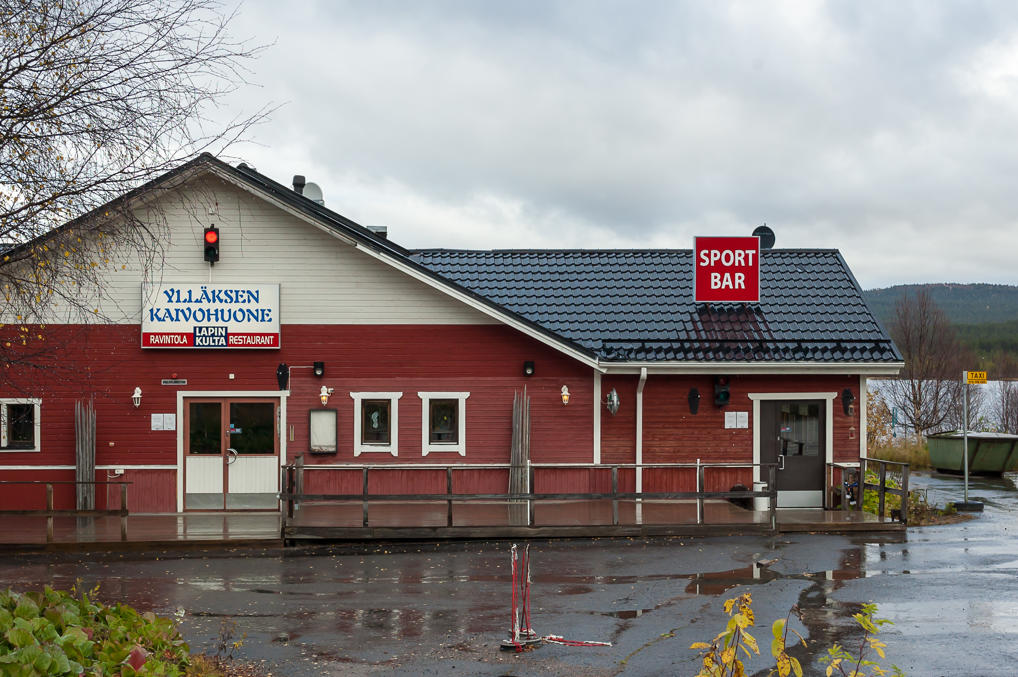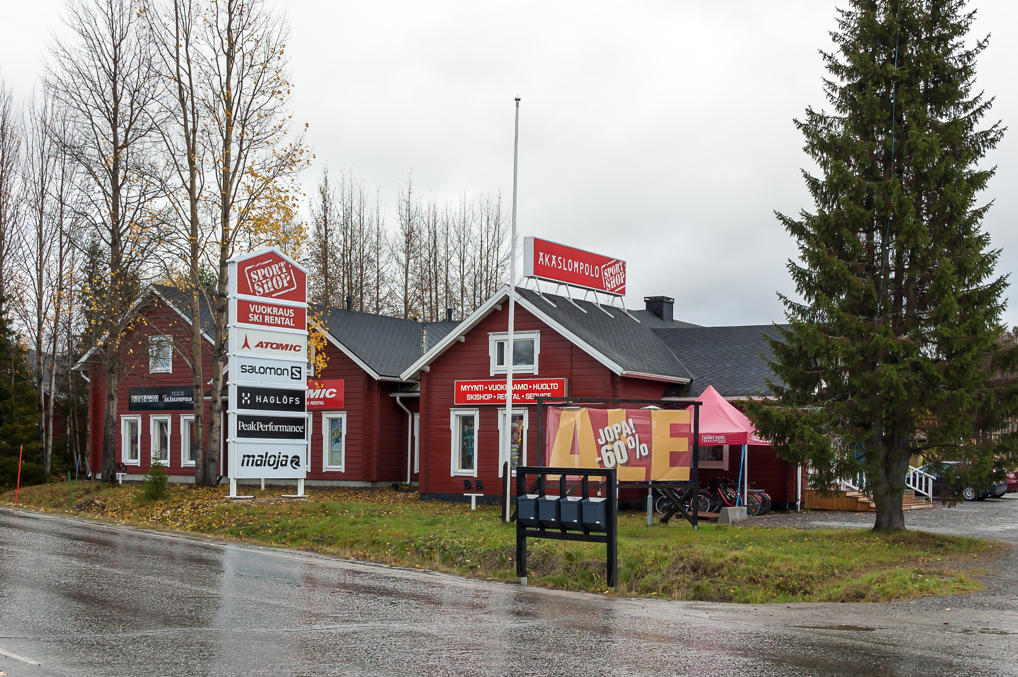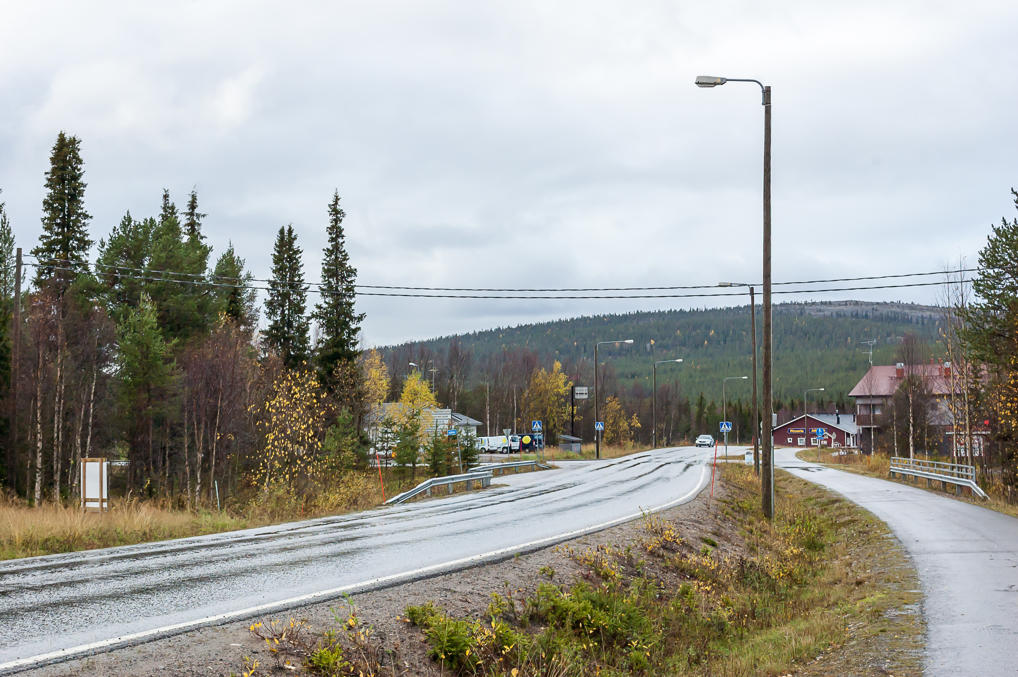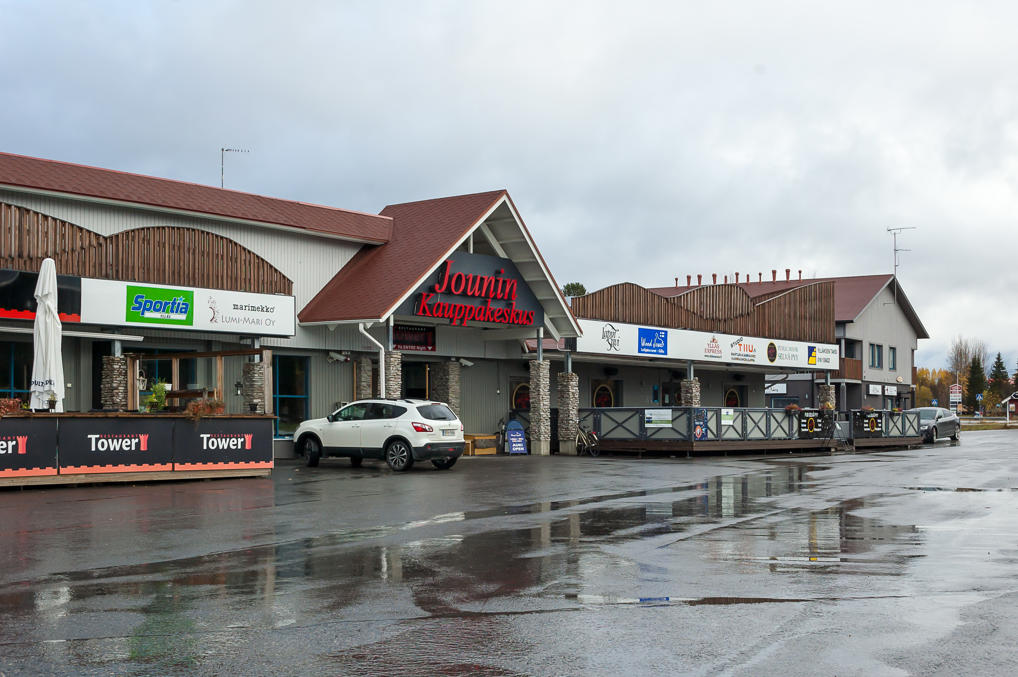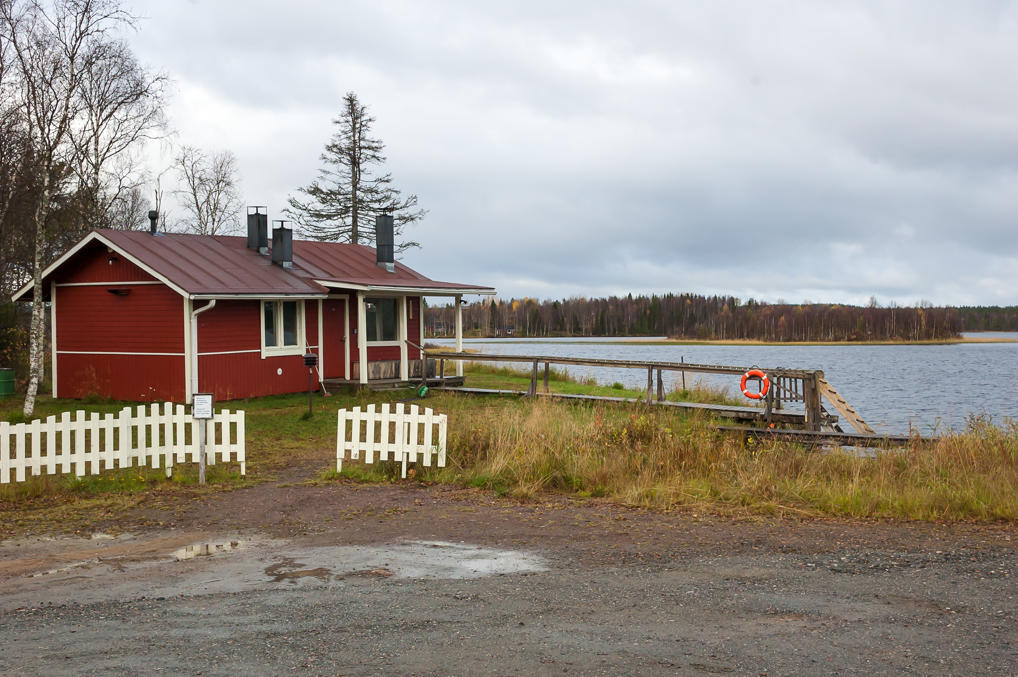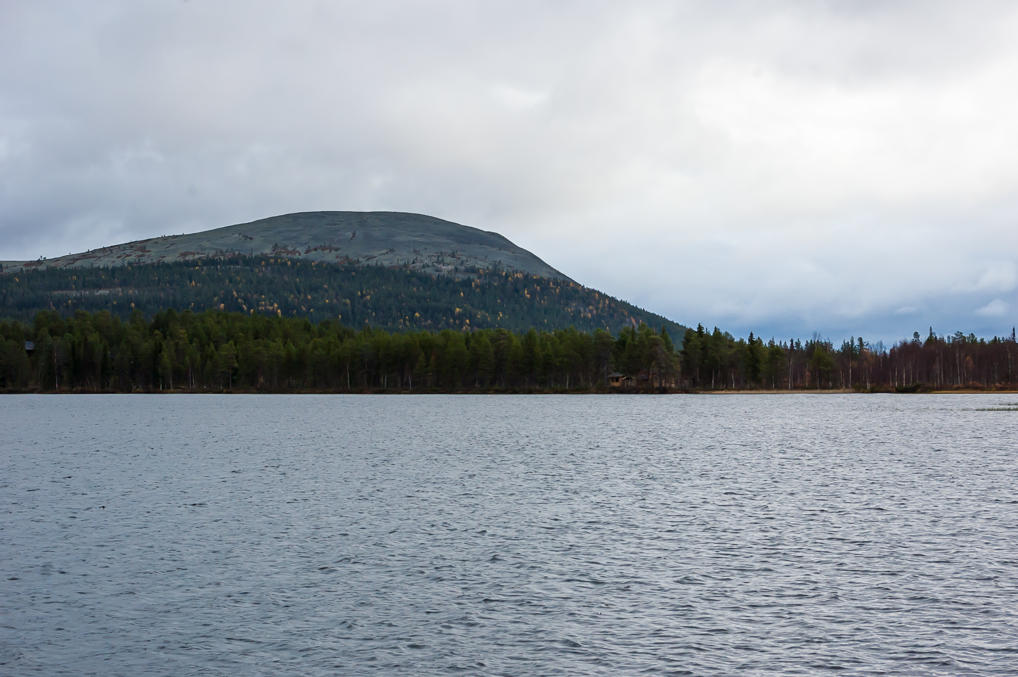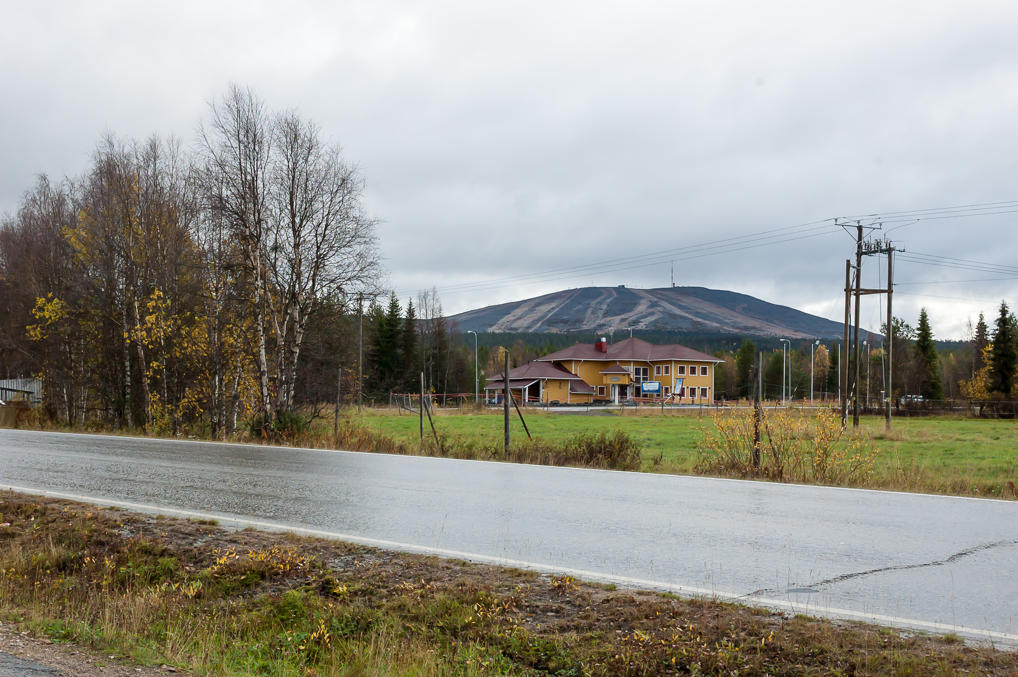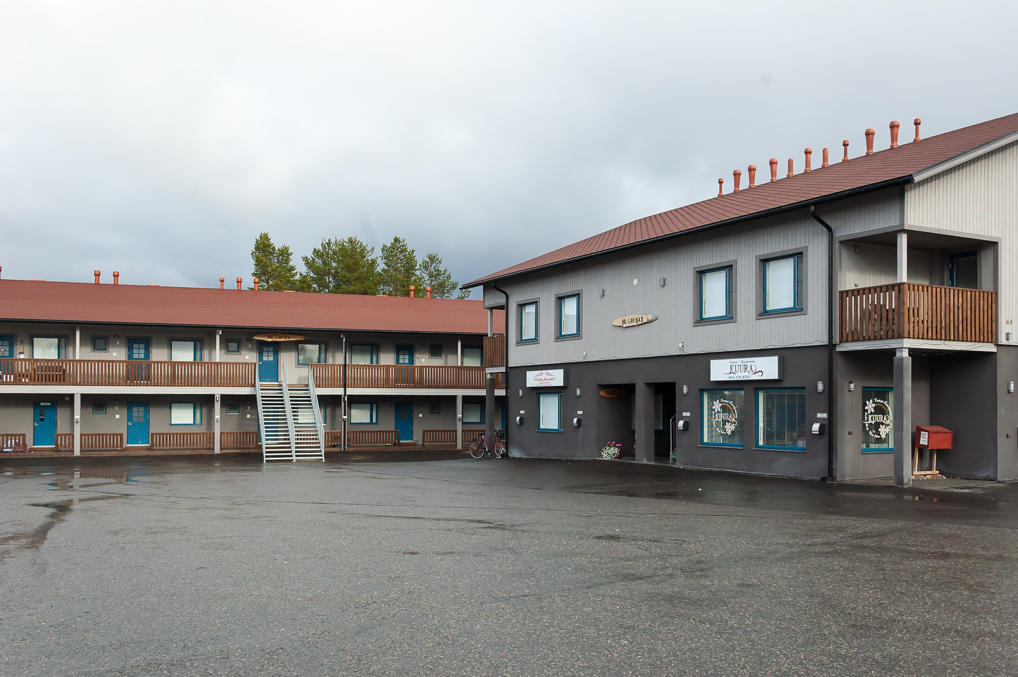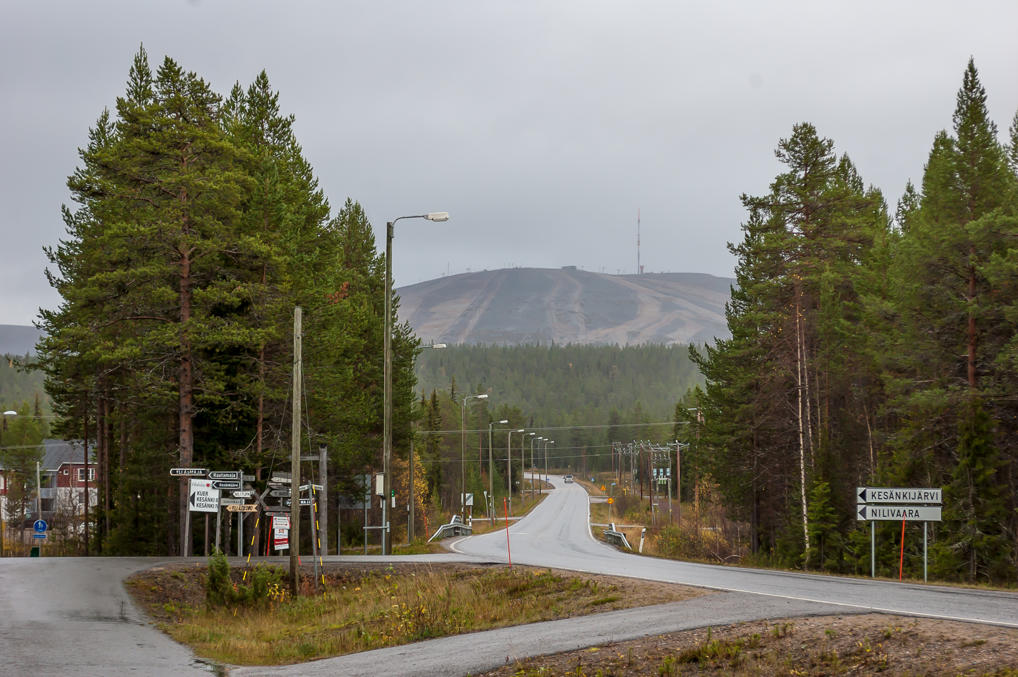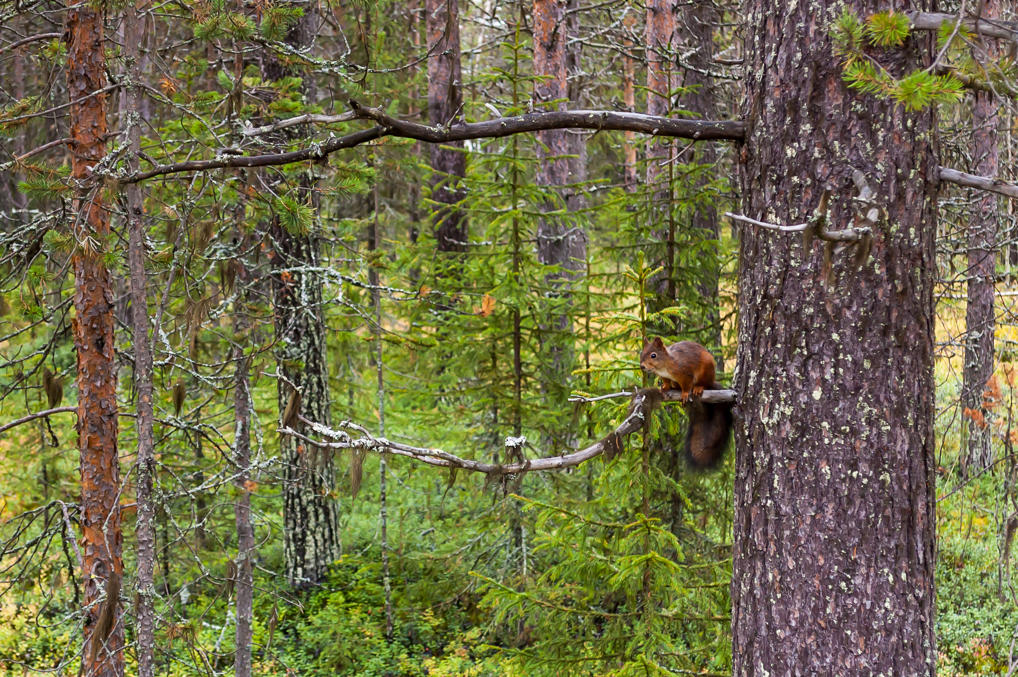So what does a Lapland ski resort cabin look like? I must say I was extremely impressed. This is the best accomodation I've ever had. It is an actual home where a person or two could live indefinitely long. (There are of course also more traditional hotels at Äkäslompolo, and there are larger cabins which accomodate more people. Mine was on the smaller side.)
1. The cabin is actually an apartment in a small row house, the middle one of three. Both outer apartments were not occupied. The exterior walls appears to be built from logs.
2. The cabin consists of a living room/kitchen, a bathroom, a sauna, and a mansard bedroom. With the exception of the bedroom, it would look a lot like a typical studio apartment.
As you see, the kitchenette is furnished pretty much perfectly, with an electric stove, a large fridge, a dishwasher (I don't even know how to use these), and all the smaller stuff like a microwave oven or a toaster. The cupboards contained an impressive amount of dishes, a bit too much for one or two people, really. There wasn't much leftover food, just a bag of crispbreads.
The fireplace of course is largely why I decided to book this cabin at all. I have never used a real fireplace, too. There was a small pile of firewood available. I decided to put off lighting it up until tomorrow
3. There was a large couch in the corner across the kitchen one. It reminded me a lot of an Ikea couch I bought with my first bonus ever ages ago.
There were a few books at the coffee table, including yellow pages, tourist brochures, and two trashy-looking novels, one in English and one in Finnish. There also was a guest book, a notebook with a picture of lighthouse, which I read through with great curiosity. The book started in the end of 2011 (I found the previous volume in some cupboard later), and a lot of records in that winter were made by British tourists, many of them coming from Wales. Most of them mentioned some Inghams meeting them here and helping them to rent skiing equipment and the like. I assumed that was just some Wales family which owned some cabins here and rented one of them out to their fellow countrymen. Apparently Inghams actually refers to a fairly big British tour operator, specializing in skiing holidays. Records from 2013-2015 became much rarer; they didn't mention Inghams anymore, and were mostly made by Finns and Germans. There were no records by Russians. Nearly all the records were very enthusiastic, talking about skiing and dog and reindeer sled riding and the other traditional winter stuff. The temperatures mentioned ranged from -36°C to -7°C. Records from summer/autumn months were nearly non-existent.
The windows and the door led onto a small back porch, which looked out directly onto a large patch of a harsh-looking spruce forest.
As you can see, I already started trying to get online using that Sonera SIM card I bought in Kolari. For some reason, it worked okay in the phone itself (I had a dual-SIM model and I kept my main Russian SIM card for emergency calls), but every time I put the phone in Wi-Fi router mode and tried to use it from my laptop, it pretty much stopped working completely. I tried for half an hour or so and couldn't even check email. I have no idea how is this possible; I had never had any issues using my phone in router mode before. In the end I gave up, but maybe it actually was for the best. When left alone with my laptop, I tend to waste inordinate amounts of time reading Reddit and various blogs and the like. This way, I had Internet on my phone for communication or in case I need to look something up, but mostly I had to find something else to occupy myself.
4. There was a TV and I spent most of my evenings with a TV turned on just to have some background noise. TV shows in Finnish were not particularly useful, but I caught a few movies in English from time to time. Like most European countries (and unlike Russia), Finland usually doesn't dub foreign moves, just slapping some Finnish subtitles on them instead.
Curiously, there was also an actual, working VHS player under the TV. Can you imagine findind one of these in 2015? Well, I assume it was working; you'd think that there would be some video tapes to watch, but I failed to find any.
The brand of the TV by the way was Finlux, and most of kitchen equipment was made by Helkama. Both of these are Finnish brands, although Finlux seems to have been bought by the Turks, and the consumer applicances division of Helkama closed its original Finnish factory in 2008. I'm kind of offended by the common claim that the actual manufacturing of literally everything has moved to China and Southeastern Asia, and Europe doesn't actually do anything important now. As far as I understand, everyday stuff like consumer applicances has really largely moved to Asia, but Europe's still unsurpassed when it comes to more expensive and specialized stuff, like construction equipment or machine tools.
5. Stairs to the mansard floor. The mansard floor is only half as large as the living room, and overlooks it.
6. There are two beds and a bedstand and not much else there.
7. The bathroom had a sink with a mirror, a shower stall, a toilet, and a washing machine. It also had a small window looking out on the parking lot, not even frosted glass or anything, which I found a bit odd. Everything worked fine, and in particular there weren't any problems with hot water.
There also was a thermostat control by the bathroom door. It was set a bit too cold when I arrived, but I turned it up, and since then the cabin felt as warm as my own apartment. I wondered if the heaters can keep it that warm when it is -36°C outside. Well, there's always the fireplace.
8. And of course it wouldn't be a Finnish cabin if it didn't have a sauna. It was a pretty usual electric sauna, I was familiar with that type. It looks like a box with stones, which are heated with electricity, and then you pour water on them.
9. At this, I finished with exploring the cabin, having been completely satisfied. I still felt pretty miserable after sixteen hours of driving. I made myself some tea, ate a few sandwiches, went to sauna for a couple of minutes, and finished off my sparkling wine in bed. I was afraid it would feel creepy to sleep alone in such a cabin, but it really wasn't, despite the dark and the odd irregular hum of the fridge, which brought into mind ambience sounds from Silent Hill games.
10. I slept well, for some ten hours or so, and then spent two hours working with photos I took the previous day, and composing a letter to my parents. I like to write them horribly detailed letters about my trips. They love it too, and for me it is a good way to write down some details before I forget them. In fact I'm using these letters very extensively now as I write this series.
And this was the view which greeted me out of the back porch window, of course.
11. It was an actual Lapland forest. It looks very different from the forests of the south of Finland or near St. Petersburg, consisting mostly of tall and very narrow spruce trees. There are many oddly twisted trees, and the ground and the trunks are extensively covered with moss. The grass cover is short but thick, largely consisting of blueberries.
12. The back porch itself. The guest book mentioned that there often were bird, squirrel, hare, and occasinally reindeer tracks in the snow near the porch in mornings.
13. By the time I finally walked out of the cozy cabin it was afternoon. I decided I would explore Äkäslompolo a bit, walking to Jounin Kauppas mall, and then try to find some short hiking trail which goes to the fells. I left my car at the cabin for this day.
As you can see, the outer sections of the row house apparently have greater floor area but no mansards. I decided that my apartment was the best one. The parking lot had engine block heater outlets. These are very common throughout entire Finland (and usually are a sure sign of a private parking spot). Of course there is no need for them in autumn, and I don't have a block heater anyway; thankfully St. Petersburg climate is not particularly harsh.
14. My street, named Niestatie. You can see other log cabins here. Most of them are probably privately owned, and are not for rent. There were only two or three cars visible, other than mine; the place seemed pretty deserted in that season.
15. And this is the main street of Äkäslompolo, named Tunturintie. The word tunturi means "fell", the fell being a relatively small mountain with bare flat top. The word tundra has in fact evolved from tunturi, although Äkäslompolo fells have tundra-like zones only at high elevations.
Tuntirientie road goes to the skiing center at the Ylläs Fell. Äkäslompolo is surronded by seven fells, named Ylläs, Lainio, Kesänki, Kellostapuli, Pyhätunturi, Kukas, and Kuer. Any one of the fells can be hiked in a single day by an unprepared moderately healthy person. Ylläs is the highest one of these feels, at 719 meters (Äkäslompolo base elevation is about 200 m), and the only one actually used for downhill skiing. On the other side of Ylläs there is another ski resort village, named Ylläsjärvi (Finn. Ylläs Lake), which is probably very similar to Äkäslompolo.
Ylläs Fell gives its name to Pallas-Yllästunturi National Park, which begins just to the east of Äkäslompolo. Pallas refers to another fell area, about 50 km to the north. There used to be two separate national parks, Pallas-Ounas and Ylläs-Aakenus, but they were merged into one in 2005. Palls-Yllästunturi is the third largest national park in Finland, with about 350 km of marked long distance hiking trails.
16. There are quite a few bars and shops on Tunturintie, but many of them are closed off-season, like this one, "Ylläs Water Well Room". This constrasts with the rest of Finland, where many minor rural museums, restauraunts, and the like work only in summer.
17. Ski equipment shop. Jopa (Finn. as low as) means "ass" in Russia, although it's pronounced differently. Border cities like Lappeenranta seem to avoid signs like "Jopa 60%" for that reason, but of course here in the middle of Lapland nobody cares.
18. The fell to the west of Äkäslompolo visible behind the Tunturintie is Kuer, the lowest one of Ylläs Range (446 m).
19. Jounin Kauppas (Finn. Jouni's Shop?) mall serves as the natural center of gravity of Äkäslompolo. It consists of two buildings, one of them housing K-Market supermarket and Alko liquor store, and the other having some souvenir, sport equipment, and clothing stores. Both buildings also have a restaurant or bar or two. I was relieved to learn than I could just sit down on a couch in the lobby of the second building (pictured) and catch free Wi-Fi from one of the bars; at the very least I still needed to send some work-related emails from my laptop.
20. The local K-Market is pretty massive. There are K-Markets in nearly every Finnish town, but I read claims that this Äkäslompolo one is actually the largest. That's pretty impressive for a village with permanent population of about 400, even for a touristy one. I had no need for grocery shopping yet though. There is also an automated gas station at the Jounin Kauppas parking lot.
By the way, Äkäslompolo was not built only because of skiing slopes, if you wonder. It's a proper old Lapland village, established in 1748, although it isn't far enough north to be a Sami settlement. Skiing only came in 20th century.
21. The first reindeer trace I saw in Lapland were these antlers for sale in a souvenir shop.
22. I ended up never eating out on that trip at all, but here is the menu of one of the restaurants if you're curious. Reindeer meat is obviously very popular.
23. From Jounin Kauppas you can easily walk to Äkäslompolo Lake, which is where the village gets its name from. Äkäslompolo actually means Äkäs Stream Pool, Äkäs (Äkäsjoki) being a mid-sized river draining into Torne. The word lompolo is commonly used for stream pools in Lapland; the usual word in Finnish toponymics is suvanto.
The building on the shore is probably a sauna, although I'm not sure.
24. The surroundings fells are prominently visible from Äkäslompolo Lake.
25. After Ylläs (which I'll get to in a moment), the highest-looking one is Kesänki. That was the fell I decided to climb the next day, all the way to that stony top and back.
26. A small camping site somewhere at Road 940, the other main street of Äkäslompolo.
27. And here in the distance is Ylläs Fell itself, instantly recognizable due to skiing slopes and a tower at the top.
28. This looks more like a traditional hotel than a cabin block, but apparently there are very few guests here either. I generally try to take pictures with as few people as possible, but even so, you may have noticed that apart from Jounin Kauppas there seems to be pretty much nobody here. The whole town is just waiting for the skiing season. Nonetheless, I saw a few other people hiking, picknicking, and cross-country cycling in the fells, and Jounin Kauppas had actually quite a few people for an off season in such a small town. I noticed that the license plates of all the cars I saw here were exclusively Finnish, the sole exception being a Swedish car parked at some private house. So the place gets only the locals and rare domestic tourists in autumn.
29. Walking back towards my cabin, I started to look for some hiking trail to move over to. The immediately obvious destination to explore was Ylläs Fell or at least its vicinity. I could walk there on a sidewalk by the side of Tunturintie road, but that seemed boring. Unfortunately I didn't have a trail map by that point; I had looked for one in my cabin and in free tourist brochures in Jounin Kauppas, but there wasn't one. Eventually I spotted a hiking trail, going in an underpass under Tunturintie, and started walking on it at random. Soon I saw some direction signs, which helped me to pick the correct trail.
30. The first non-human Äkäslompolo inhabinant I encountered.
31. There were lots of berries even right by the Tuntirintie shoulder. I hoped to find some cloudberries which Lapland is famous for, but I never found any. I think they ripen much earlier in the summer. There were various odd mushrooms too, like these ones resembling turtle shells.
32. It seems even the smallest gravel roads here in Lapland have these bright orange poles, which help to keep road visible even when it is completely swept over with snow. Occasionally they can be seen in southern regions, too, but they're nowhere that common there.
Having found the correct trail, I walked to the Ylläs skiing center, and then onto Varkaankuru nature trail. To be continued.
